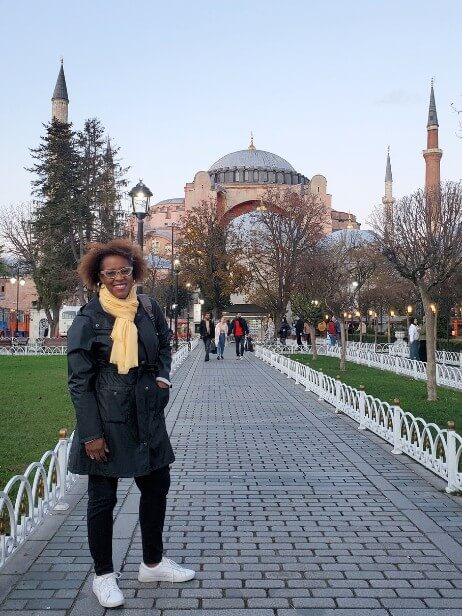Minarets in the Istanbul Skyline
Modern Turkey’s (1923) constitution deems it a secular republic that separates church and state. However, Islam is inextricably woven into its culture, architecture, social graces and traditions. Children born in Turkey are given a religious affiliation at birth, and the government reports that nearly 99% of Turks are Muslim. The reality is that people in Turkey, especially in Istanbul, have varying degrees of religious affinity–atheist, devout, or otherwise–just as we see in any other contemporary society around the world. In addition, there have been political rubs against secularism in recent decades.
United in Prayer
In Istanbul, if you do not see a mosque when you look left, you will see one when you look right. There are over 85,000 of them in Turkey, a country that is about 16% larger than the U.S. state of Texas. They come in all shapes and sizes, each with its own unique interior design. I found myself most enamored with mosques that had boldly painted tiles as opposed to stencils or calligraphy. That said, a commonality in my observations is that each mosque I saw stood nobly and inspired awe in its architectural simplicity and complexity.

Five times a day minarets come to life. The tall, slender towers of the mosque, fitted with loudspeakers, send the call to prayer through the air. Fajr: dawn prayer, Dhuhr: midday prayer, Asr: late afternoon prayer, Maghrib: sunset prayer and Isha: evening prayer. With mosques proclaiming the prayer time roughly in unison, it sounds like a chorus! Restaurant music is respectfully turned down, some entertainment may come to a halt and religious observers may step away to pray. The audio of the call is so dominant, especially when outside, that even non-Muslims tend to pause even if only to avoid their conversations being drowned out. Istanbul’s fever pitch of urban activity seems to slow just long enough to take a deep breath and exhale.
The Infamous Blue Mosque
If you pull up any list of must-dos in Istanbul, a visit to Sultanahmet, the legendary Blue Mosque, is on the list. Famed for its six minarets and 20,000 handmade ceramic Iznik tiles, the mosque was built between 1609 and 1616. As much as I like to incorporate the unique and novel into my travel, I did want to step inside this icon of a structure. It has been under restoration since July 2017, which I knew, however, once I got inside, I was underwhelmed. There was just so much scaffolding! Fortunately, I was still able to stand, mouth agape, and stare up at the impressive, intricately patterned dome, but my view was obstructed by construction platforms, tarps and plywood. Guess that means I will have to go back!


Hagia Sophia
With so many mosques in Istanbul, my disappointment about the Blue Mosque was easy to resolve. Equally grand, of an earlier vintage and often lower on the list of must-dos, is Hagia Sophia, which is literally across from the Blue Mosque. My, my, if its walls could talk! This third incarnation of Hagia Sophia was built in 537 as a Christian church. It was converted to a mosque after the fall of Constantinople in 1453, became a museum in the 1930s and then in 2020 it reopened as a mosque. The decision to convert Hagia Sophia from a museum back to a mosque was seen as a non-secular political move and prompted local and global backlash. Remnants of its many lives remain visible in the tilework and paintings that adorn its walls. I was so taken by the ceiling that I had to stop walking and stand in one spot, otherwise, I would continue to bump into people because I was looking up and not where I was going.


My Favorite Mosque in Istanbul
Recognizing my cultural curiosity and penchant for details, one of my guides suggested that I visit Rüstem Paşa Mosque. His recommendation was spot on! Of all the mosques I visited, this one was my favorite. Located only meters from the frenzy of the historic Spice Bazaar, it rests several floors above the shop stalls, surrounded by a small, walled courtyard and neighboring treetops. Despite its location, it feels far removed from the bustle of the market below. Rüstem Paşa pre-dates the Blue Mosque by 50 years. They share the design feature of walls covered in Iznik tiles. To my delight, and unlike Sultanahmet, these blue tiles are fully on display, to be admired and appreciated—up close. I could have spent my afternoon there, cloaked in its moody blue quietude.

Visiting mosques in Istanbul felt a lot like visiting churches and cathedrals in Europe. I respect the religious intent of each, and as a traveler, I am grateful for the opportunity to experience and learn about them. Civilizations have been built and destroyed around religion and I see historical markers in the use, decoration and architecture of the surviving affiliated structures and institutions.








